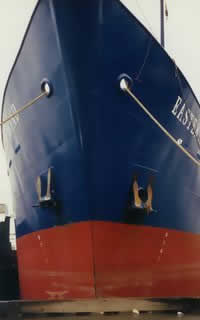
The Alaska Halibut Equation
January 22nd, 2006
Although I don't think he has just now seen the light, that most famous Alaskan sport-fishing writer, Craig Medred, has been pushed just a little too far with the new plan to cut the sport halibut catch to one fish.

The Alaska Draggers Association and these boats are a big component of the equation.
In a recent piece in the Anchorage Daily News, he blasts the concept of private rights to the halibut resource in Alaska as the culprit behind it. And he points out that 17 of the top 20 "shareholders" of the halibut resource are lower 48 fishing corporations.
I'm pretty sure Craig is aware that the same thing is going on in the rest of the commercial fisheries off Alaska's coasts, but now these business interests are sticking it to his readers. Welcome to the club. They have been sticking it to the rest of Alaska's coastal economy for decades. It's just business. You do what you can to maximize your commercial fishing profits, right?
It's been to Alaska's shame that privatizing has been allowed to happen. In Oregon, Washington and California, recreational fishermen get half the halibut. In Florida's $6 billion industry, it's even more. Economists warned there would be problems with privatizing, but then special interests were making the rules. But Alaska Governors get elected by allowing it to happen, except the most recent one. It'll be interesting to see what happens now. As the privatizing of Alaska's fisheries siphons the resource wealth out of the state, charter halibut fishing operations and other attendant visitor industry businesses have propped up the economies of the coastal communities. Pull a key prop and just see what happens.
The background according to John: When I went out on a halibut trip for the first time in the very early 1960s at about 13 years of age, the boats took a eight day lay-up between trips. Longlining trips out of Petersburg lasted around 10 days. If you were from Seattle and had refrigeration coils in your hold, you could make a 21 day trip. The boats fished all summer and it wasn't fun. Later I executed a federal contract and invented an automatic baiting machine. I've done a little research myself on longlining.
As hot young blood got into the game, they weren't content to spend a little time with their families in a mandatory lay-up, so out the window that went. Then it just escalated into a couple day derby, which I participated in too, twenty odd miles off Yakutat in the Gulf of Alaska. Then when some folks came up with the bright idea that the existing fishermen should get private rights that could be sold, there wasn't much objection from the fishermen. The ones that pioneered the commercial fishery were gone and weren't defending their clans. It was a slam dunk. There were no thorough studies, just power politics.
Halibut come up shallow enough to sport fish for in the middle of June in order to spawn. This coincides with tolerable weather, especially in Southcentral Alaska, and hence the influx of visitors wishing to take a crack at catching halibut. The IPHC doesn't make the rules, just suggests them. So now is a good time to speak up. I figure if my son is going back into war this spring to fight for personal freedom from oppression, I can do my part to do the same here. Don't rely on the media to bring up these issues, this one just happened to be kinda understood by the main sports fishing writer in Alaska.
Well, I reckon this blow to personal use and the visitor industry by non-resident owners is where Craig and others take a stand for the people. Especially when commercial fishing interests kill and discard 14 million pounds of halibut compared to the whole sport catch of 9 million pounds of table fare. 14.1 million was Craig's count, but actually it's much higher. You also have to count the halibut under 24 inches that are discarded by the trawlers that the IPHC doesn't make them count. If you drag a trawl through nursery grounds, all you'll get is chicken halibut. In any event, longliners shake a lot of chickens and it figures that the trawlers get a lot too. So, how many? Nobody is saying, but it may push the total to closer to 17 or 18 million pounds of discard. Does that sound like the IPHC is a truly scientific outfit?
It may be that the International Pacific Halibut Commission has awakened a sleeping giant, the public in Alaska itself. Maybe Alaska state government is just not able to ever stand up to the out-of-state commercial fishing and processing interests. But I reckon if there ever was a chance it's now, with the public behind it. This won't be an instant process. The new Governor has a lot of wreckage to clear from past administrations. And she doesn't seem to be inclined to be "unequally yoked" with bad appointments. There just aren't that many untainted industry folks around to pick from to create a "David's army."
Let's make this more interesting still. I propose a handline commercial category to equal the annual commercial wastage. That would give some impetus behind the IHPC suggesting a zero tolerance for halibut by-catch in the bottom trawl fishery. I think the Jackson family in the Tlingit village of Kake should be able to catch and sell handline halibut like they did for thousands of years. It would be a win-win situation.
If every fisher was limited to 200 lbs a day, and assume he or she fishes about 20 full days a summer, that would allow 4,500 fishers to value-add and/or direct market product worth about $110 million. Figure a multiplier effect of five and you get an economic boost of $550 million to the coastal towns. This is a day fishery, so non-residents would tend not to do it. No more fish were caught, the commercial fleet sells the same amount, the charter operators and sport anglers could keep their two fish per person limit (capping their total at 10 million lbs), and there's joy in Mudville. Except Al Burch would be hopp'n mad.
See more at John Enge's Blog
See John Enge's Previous Posts On AlaskaReport Here
John lived in Alaska for 50 years and has run commercial boats and processing plants. John also served as a loan officer and economist for a "fishing bank" and served as the only Fisheries Infrastructure Development Specialist the state has had. He has owned a marine design and fabrication business and created the best-selling "Passport Alaska." All photos on his blog are his own, unless so noted.
Contact John Enge

